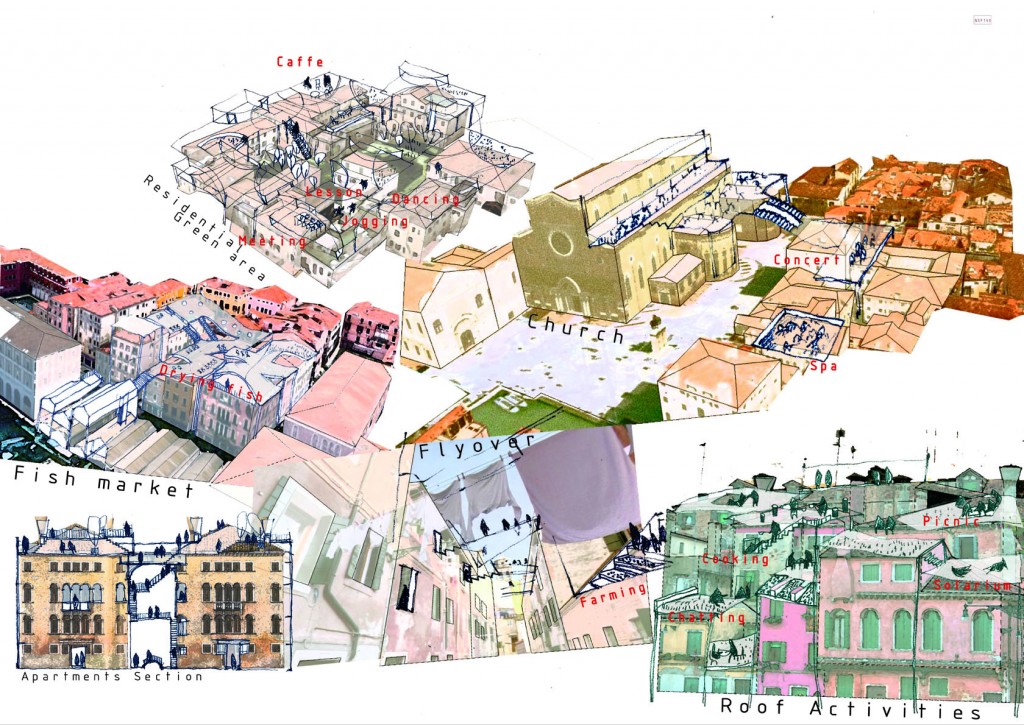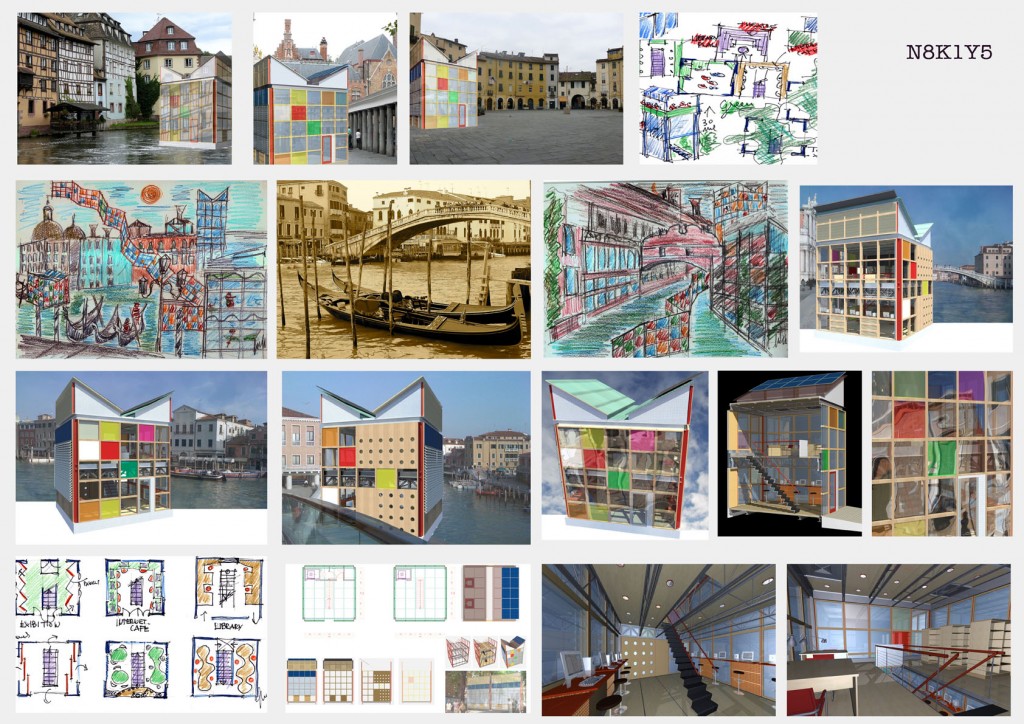Info:
Title: “The Monolith Arlecchino” - Code: N8K1Y5Contest: Venice / 2011
By: G. Campagnoli / S. Biondo
Views: 3562 Likes: 0
Votes:
BJARKE INGELS4 NERI OXMAN5 ELENA MANFERDINI7 MARIA LUDOVICA TRAMONTIN3 BOSTJAN VUGA14.0
“The Monolith Arlecchino”
A MIRROR CUBE FOR VENICE “The Monolith Arlecchino” A mirror for a city that cannot be contaminated. A diffuse object, mimetic and apparently indifferent, an almost non-architecture from which to observe the city, document the city, exhibit the city, interrogate the city in a continuous dialogue …
A quotation from the theatre of the world in the theatre from the world. The Mirror Cube is now coming to Venice! Every object will be from time to time a newsstand, a cyber café, an exhibition, a wharf, a tower, a bridge, a small theatre according to the images and shapes it reflects or projects on its surface, hiding itself from the view or exhibiting itself or replicating the façades, the water, the windows, the chimneypots …
The monolith is self sufficient and self replicating in diffusing itself in different dimensions among campi and campielli, calles and canals, respecting the finite shape of the city, a shape that it is impossible to modify without contamination, because it is to be considered already accomplished. The monolith unifies the “finite” cities of Europe and connects them through a thread that although invisible is identifiable and rich of meanings.
In fact we do believe that the only possible intervention in historical centers in Venice as in Wien, London or Paris, because respectful and not conservative, concerns the “make up” of historical buildings and their protection, as well as the mobile and precarious craftworks as it was the “world theatre” by Aldo Rossi, our late master.
It is a choice made in order not to trust the “stars” of contemporary architecture, nor the actual qualification of designers that seem not to be capable to “complete” the drawing of cities like Venice, because in today’s individualist, functional, hyper technological, hyper eclectic architecture there is no modern style that can proficiently converse in the shape, continuing the “discourse” of the historical city in modern key.
Today it is all about hyper technology and wonders, it is all about images and hyperboles, advertising and narcissism.
Our object is a door and a window, a courtyard and a street, it uses technology but doesn’t show it, because it shows the shapes of the city where it lives by reflecting them, narrating them, making them modern with due detachment.
The space can be built in many European cities, but it is not indifferent to the cities because it is mimetic and it is mirrored in their shapes, until it resembles them, while it performs the function of cyber café, info point, newsstand, small theatre and “of the world”!
In the examples shown in the plates the same “mysterious object” is shown in different backgrounds and finally in the Venetian context.
It is a multifunctional, flexible and mimetic space.
A classical, modern, specular and scenic space.
A space that catches the surrounding scenes and façades, the faces, the gardens, the sky, the environment, the history of the city.
Materials can be different but the essence is transparency: glasses, mirrors, screens and enormous “living” blow-ups: a space within and outside…
The commonplace of the “cube” is revalued because it becomes a “non cube” as it takes on, thanks to its mimetic surfaces, the shapes of the surrounding environment and of the city and the gardens … but it can yet be a cube, like the Louvre Pyramid or the Black Monolith of “2001: A space Odyssey”.
A space that is human because it can be controlled and it is not domineering, because it is simple and predictable and unpredictable: once a class, once a café, once a library or all these together, aligned, in a courtyard, in the shape of a tower!
A tower on the city!
A “cultured” break while roaming in the city for tourism, work, barter or leisure…
A break that is full of suspended meanings and thoughts …
The founding elements. “the parts” are archetypal elements of architecture: the beam, the pillar, the panel, the stair … but everything becomes a harmonious autonomous whole and it can be replicated in different places and different levels of the city with different dimensions and uses: a change of dress and a change of “habitus” (appearance, behavior): from a theatre to a square, to a tower to look at the ascending city and be looked at from the descending city.
The architectural structure can be put in the historical city and also at the edge of the modern or pseudo modern city and it set itself in a dialogical way by integrating or disintegrating according to the urban design purposes: it opens, it closes itself, it superimposes itself, it draws closer, it staggers and it constantly creates new streets, new squares, new gardens.
There are many ways to aggregate the fundamental panel and the basic prismatic module.
Its sides are “alive”, like its “solar” roof, climber plants inside and outside, water that keeps the environment fresh or warm depending on circumstances, the light, fixed or moving images. Pictures outside, mural paintings, screens, advertisements, information.
Materials: light: Kraft cardboard, aluminium, wood, temperate glass, rubber … everything must be recycled material.
The structure: isolated, quake proof, self sufficient…
The aluminium frame lifted from the ground through special insulators is like a “meccano” that constitutes the main structure where to attach perimetric panels, internal panels, stairs, equipments etc. everything is self supporting.
The style corresponds to the surrounding environment but it can also be opposite to it or it can represent the future of that same environment.
The starting volumetric idea can seem a commonplace but instead it represent a concept of geometric certainty, of spatial and architectural memory and so it is not obsolete.
The primary idea is widened and complicated assuming different meanings according to the surrounding environment where it is put, where it camouflages itself or shows itself from time to time according to the purposes or provocations of the person that “dresses” it.
It is a magical object, diffused in a magical city!
Info:
Title: “The Monolith Arlecchino”
Time: 6 giugno 2011
Category: Venice
Views: 3562 Likes: 0
Tags: Aldo Rossi , Arts , Biondo , Campagnoli , London , Louvre Pyramid , Mimesis , Paris , Rome , Venice








